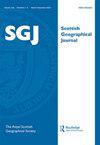塑造景观和产业:将历史悠久的水车位置与基岩河流拐点连接起来
IF 2
4区 社会学
Q2 GEOGRAPHY
引用次数: 2
摘要
本文章由计算机程序翻译,如有差异,请以英文原文为准。
Shaping landscapes and industry: linking historic watermill locations to bedrock river knickpoints
ABSTRACT Watermills have been an essential source of mechanical power for over two millennia. Their careful siting often took into account local hydrology, topography, and economic demand, attesting to the important place they held in premodern and early modern societies. This paper highlights the significance of Paul Bishop's work on mills over the last 20 years, which revealed that numerous historical watermills along Scottish rivers were closely located near overly steep stretches of river to maximize waterpower and minimize cost. Termed ‘knickpoints’, many of these steep erosional features formed thousands of years ago during and after melting of the British–Irish Ice Sheet. Post-glacial isostatic rebound caused rivers to erode into bedrock at rates set by river catchment size and sediment availability. Although bedrock knickpoints along the Scottish coast are relatively stable over human timescales (<103 years), knickpoints generated by milling in England have been invoked as potential hazards due to their potential to migrate over similar timescales. Bishop's observations on the colocation of knickpoints and watermills encouraged a more comprehensive investigation of the relationship between natural and human systems over the last 250 years and invited re-evaluation of prevailing narratives for the history of water technology and patterns of water-powered industrialization in Britain.
求助全文
通过发布文献求助,成功后即可免费获取论文全文。
去求助
来源期刊

Scottish Geographical Journal
GEOGRAPHY-
CiteScore
1.80
自引率
20.00%
发文量
19
期刊介绍:
The Scottish Geographical Journal is the learned publication of the Royal Scottish Geographical Society and is a continuation of the Scottish Geographical Magazine, first published in 1885. The Journal was relaunched in its present format in 1999. The Journal is international in outlook and publishes scholarly articles of original research from any branch of geography and on any part of the world, while at the same time maintaining a distinctive interest in and concern with issues relating to Scotland. “The Scottish Geographical Journal mixes physical and human geography in a way that no other international journal does. It deploys a long heritage of geography in Scotland to address the most pressing issues of today."
 求助内容:
求助内容: 应助结果提醒方式:
应助结果提醒方式:


